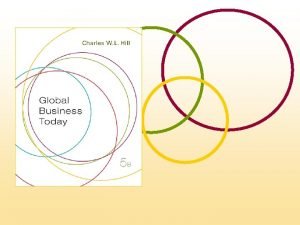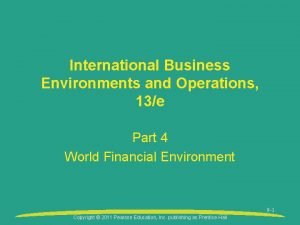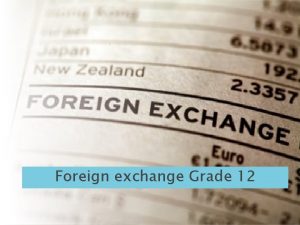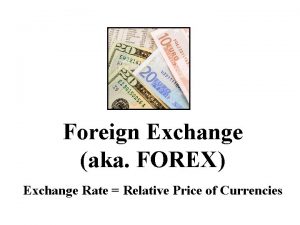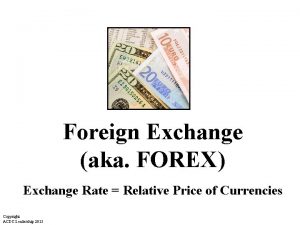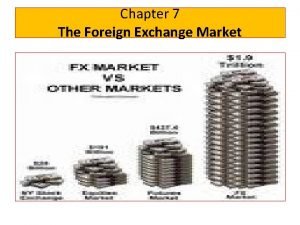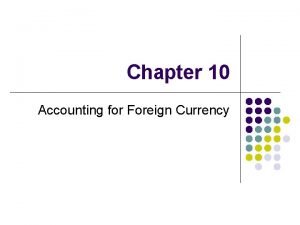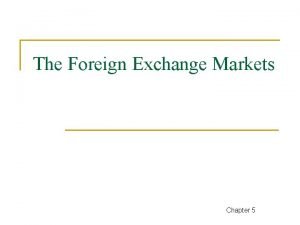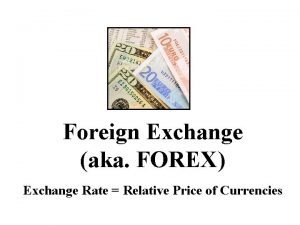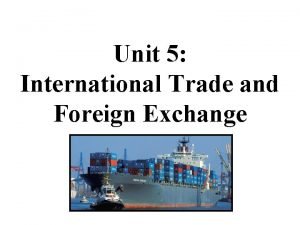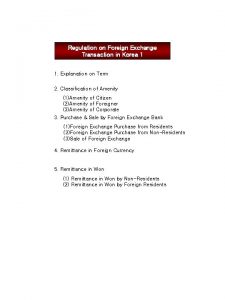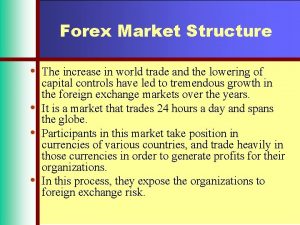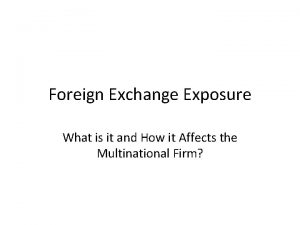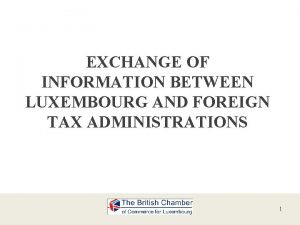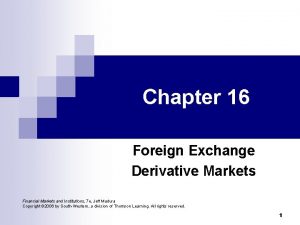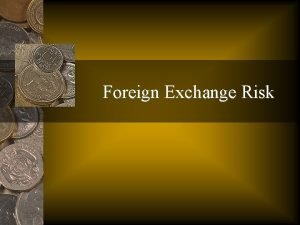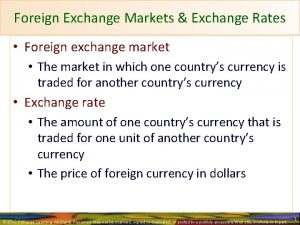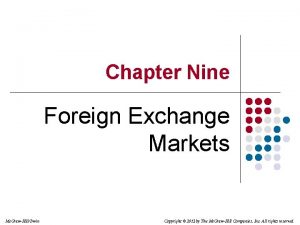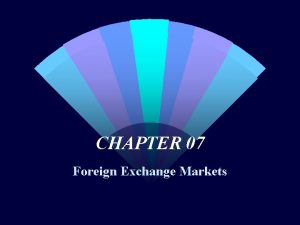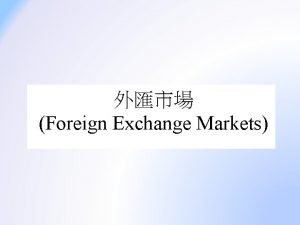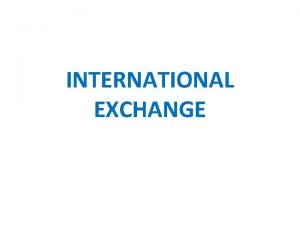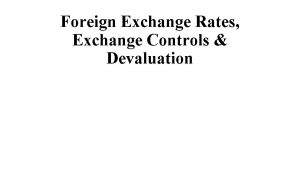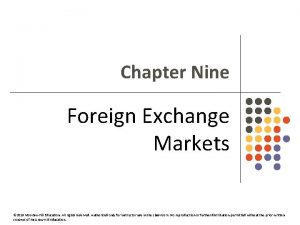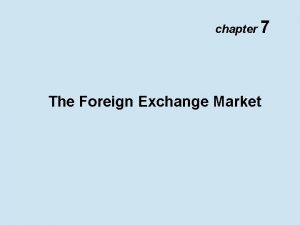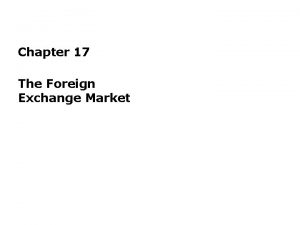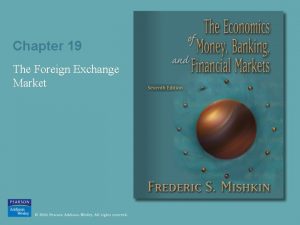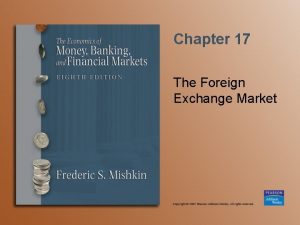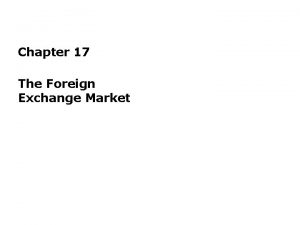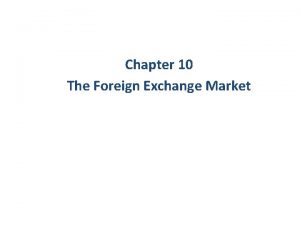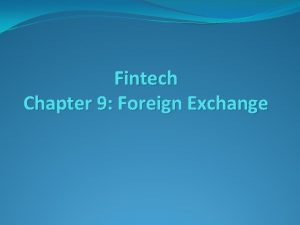Chapter Nine Foreign Exchange Markets Mc GrawHillIrwin 8




















- Slides: 20

Chapter Nine Foreign Exchange Markets Mc. Graw-Hill/Irwin 8 -1 © 2009, The Mc. Graw-Hill Companies, All Rights Reserved

Overview of Foreign Exchange Markets • Today’s U. S. -based companies operate globally • Events and movements in foreign financial markets can affect the profitability and performance of U. S. firms • Foreign trade is possible because of the ease with which foreign currencies can be exchanged – U. S. imported $2. 9 trillion worth of goods in 2007 – U. S. exported $2. 2 trillion worth of goods in 2007 • Internationally active firms often seek to hedge their foreign currency exposure Mc. Graw-Hill/Irwin 9 -2 © 2009, The Mc. Graw-Hill Companies, All Rights Reserved

Foreign Exchange • Foreign exchange markets are markets in which cash flows from the sale of products or assets denominated in a foreign currency are transacted • Foreign exchange markets – – facilitate foreign trade facilitate raising capital in foreign markets facilitate the transfer of risk between market participants facilitate speculation in currency values • A foreign exchange rate is the price at which one currency can be exchanged for another currency Mc. Graw-Hill/Irwin 9 -3 © 2009, The Mc. Graw-Hill Companies, All Rights Reserved

Foreign Exchange • Foreign exchange risk is the risk that cash flows will vary as the actual amount of U. S. dollars received on a foreign investment changes due to a change in foreign exchange rates • Currency depreciation occurs when a country’s currency falls in value relative to other currencies – domestic goods become cheaper foreign buyers – foreign goods become more expensive for domestic purchasers • Currency appreciation occurs when a country’s currency rises in value relative to other currencies Mc. Graw-Hill/Irwin 9 -4 © 2009, The Mc. Graw-Hill Companies, All Rights Reserved

Foreign Exchange • Foreign exchange markets operated under the gold standard through most of the 1800 s – U. K. was the dominant international trading country until WWII forced it to deplete its gold reserves to purchase arms and munitions from the U. S. • 1944: Bretton Woods Agreement fixed exchange rates within 1% bands • 1971: Smithsonian Agreement increased bands to 2 ¼% • 1973: Smithsonian Agreement II introduced “managed” free float Mc. Graw-Hill/Irwin 9 -5 © 2009, The Mc. Graw-Hill Companies, All Rights Reserved

Foreign Exchange • Foreign exchange markets are the largest of all financial markets: turnover averaged $3. 2 trillion per day in 2007 – London accounts for 42. 5% – New York accounts for 23. 8% – France accounts for 7. 1% • Prior to 1972, the only channel through which foreign exchange occurred was through banks – twenty-four hours a day over-the-counter (OTC) market among major banks – electronic trading of spot and forward contracts – over 90% of contracts are settled with delivery of currency Mc. Graw-Hill/Irwin 9 -6 © 2009, The Mc. Graw-Hill Companies, All Rights Reserved

Foreign Exchange • Organized markets have existed since 1972 – International Money Market (IMM) (a subsidiary of the Chicago Mercantile Exchange (CME)) is based in Chicago – derivative trading in foreign currency futures and options – less than 1% of contracts are completed with delivery of the underlying currency • In 1982 the Philadelphia Stock Exchange (PHLX) became the first exchange to offer around-the-clock trading of currency options Mc. Graw-Hill/Irwin 9 -7 © 2009, The Mc. Graw-Hill Companies, All Rights Reserved

The Euro (€) • The European Community (EC) was formed in 1967 by consolidating three smaller communities – European Coal and Steel Community – European Economic Market – European Atomic Energy Community • The Maastricht Treaty of 1993 set the stage for the eventual creation of the Euro – created an integrated system of European central banks overseen by a single European Central Bank (ECB) • The Euro (€), the currency of the European Union (EU), began trading on January 1, 1999 when eleven European countries fixed their currencies’ exchange ratios • Euro notes and coins began circulating on January 1, 2002 Mc. Graw-Hill/Irwin 9 -8 © 2009, The Mc. Graw-Hill Companies, All Rights Reserved

The Euro (€) • The U. S. dollar depreciated against the euro in the mid 2000 s • The Central Bank of Russia has replaced some of their U. S. dollar reserves with euros, as has the Chinese Central Bank • In 2007, 39% of foreign exchange transactions are denominated in euros, compared to 32% denominated in U. S. dollars Mc. Graw-Hill/Irwin 9 -9 © 2009, The Mc. Graw-Hill Companies, All Rights Reserved

The Yuan • In the early 2000 s the international community pressured China to allow its currency (the yuan) to float freely instead of pegging it to the U. S. dollar – a depreciated U. S. dollar had caused the yuan to become undervalued – Chinese exports were relatively cheap, which hurt domestic manufacturing in other countries • On July 21, 2005 the Chinese government began a policy of “managed” float – global interest rates and oil prices have since risen – China has cut back on foreign securities purchases Mc. Graw-Hill/Irwin 9 -10 © 2009, The Mc. Graw-Hill Companies, All Rights Reserved

Foreign Exchange • Foreign exchange rates may be listed two ways – U. S. dollars received per unit of foreign currency (in US$) – foreign currency received for each U. S. dollar (per US$) • Foreign exchange can involve both spot and forward transactions – spot foreign exchange transactions involve the immediate exchange of currencies at current exchange rates – forward foreign exchange transactions involve the exchange of currencies at a specified exchange rate at a specific date in the future Mc. Graw-Hill/Irwin 9 -11 © 2009, The Mc. Graw-Hill Companies, All Rights Reserved

The U. S. Dollar ($) • The largest foreign holders of U. S. dollars are China, Russia, Brazil, and India • The U. S. dollar depreciated between 2002 and 2007 as, among other things, relatively high interest rates in the euro area attracted investment capital away from the U. S. • There has also been a high volume of Asian central bank intervention – Japanese Ministry of Finance increased U. S. asset purchases – Chinese Monetary Authority bought U. S. dollar reserves, but maintained a pegged currency – India, Korea, and Taiwan have all attempted to limit their currencies’ appreciation relative to the U. S. dollar Mc. Graw-Hill/Irwin 9 -12 © 2009, The Mc. Graw-Hill Companies, All Rights Reserved

Foreign Exchange Risk • The risk involved with a spot foreign exchange transaction is that the value of the foreign currency may change relative to the U. S. dollar • Foreign exchange risk can come from holding foreign assets and/or liabilities • Suppose a firm makes an investment in a foreign country: – convert domestic currency to foreign currency at spot rates – invest in foreign country security – repatriate foreign investment and investment earnings at prevailing spot rates in the future Mc. Graw-Hill/Irwin 9 -13 © 2009, The Mc. Graw-Hill Companies, All Rights Reserved

Foreign Exchange Risk • Firms can hedge their foreign exchange exposure either on or off the balance sheet • On-balance-sheet hedging involves matching foreign assets and liabilities – as foreign exchange rates move any decreases in foreign asset values are offset by decreases in foreign liability values (and vice versa) • Off-balance-sheet hedging involves the use of forward contracts – forward contracts are entered into (at t = 0) that specify exchange rates to be used in the future (i. e. , no matter what the prevailing spot exchange rates are at t = 1) Mc. Graw-Hill/Irwin 9 -14 © 2009, The Mc. Graw-Hill Companies, All Rights Reserved

Foreign Exchange • A financial institution’s overall net foreign exchange exposure in any given currency is measured as Net exposurei = (FX assetsi – FX liabilitiesi) + (FX boughti – FX soldi) = net foreign assetsi + net FX boughti = net positioni where i = ith country’s currency • A net long (short) position is a position of holding more (fewer) assets than liabilities in a given currency Mc. Graw-Hill/Irwin 9 -15 © 2009, The Mc. Graw-Hill Companies, All Rights Reserved

Foreign Exchange • A financial institution’s position in foreign exchange markets generally reflects four trading activities – purchase and sale of foreign currencies for customers’ international trade transactions – purchase and sale of foreign currencies for customers’ investments – purchase and sale of foreign currencies for customers’ hedging – purchase and sale of foreign currencies for speculation (i. e. , profiting through forecasting foreign exchange rates) Mc. Graw-Hill/Irwin 9 -16 © 2009, The Mc. Graw-Hill Companies, All Rights Reserved

Purchasing Power Parity • Purchasing power parity (PPP) is theory explaining the change in foreign currency exchange rates as inflation rates in the countries change i = interest rate IP = inflation rate RIR = real rate of interest US = the United States S = foreign country Mc. Graw-Hill/Irwin 9 -17 © 2009, The Mc. Graw-Hill Companies, All Rights Reserved

Purchasing Power Parity • Assuming real rates of interest are equal across countries • Finally, the PPP theorem states that the change in the exchange rate between two countries’ currencies is proportional to the difference in the inflation rates in the countries SUS/S = the spot exchange rate of U. S. dollars per unit of foreign currency Mc. Graw-Hill/Irwin 9 -18 © 2009, The Mc. Graw-Hill Companies, All Rights Reserved

Interest Rate Parity • The interest rate parity theorem (IRPT) is theory that the domestic interest rate should equal the foreign interest rate minus the expected appreciation of the domestic currency i. USt = the interest rate on a U. S. investment maturing at time t i. UKt = the interest rate on a U. K. investment maturing at time t St = $/£ spot exchange rate at time t Ft = $/£ forward exchange rate at time t Mc. Graw-Hill/Irwin 9 -19 © 2009, The Mc. Graw-Hill Companies, All Rights Reserved

Balance of Payments Accounts • Balance of payments accounts summarize all transactions between citizens of two countries – current accounts summarize foreign trade in goods and services, net investment income, and gifts, grants, and aid given to other countries – capital accounts summarize capital flows into and out of a country Mc. Graw-Hill/Irwin 9 -20 © 2009, The Mc. Graw-Hill Companies, All Rights Reserved
 Types of exchange rate
Types of exchange rate When entering foreign markets basic entry
When entering foreign markets basic entry Entering foreign markets
Entering foreign markets Too foreign for home too foreign for here
Too foreign for home too foreign for here Foreign exchange process
Foreign exchange process Foreign exchange tourism grade 12
Foreign exchange tourism grade 12 Foreign exchange shifters
Foreign exchange shifters 4 forex shifters
4 forex shifters Kinds of foreign exchange market
Kinds of foreign exchange market Foreign exchange accounting
Foreign exchange accounting Foreign exchange market objectives
Foreign exchange market objectives Xlri exchange program
Xlri exchange program Foreign exchange shifters
Foreign exchange shifters Difference between balance of trade and balance of payment
Difference between balance of trade and balance of payment Foreign exchange transaction regulation korea
Foreign exchange transaction regulation korea Markets
Markets Structure of the forex market
Structure of the forex market Foreign exchange exposures
Foreign exchange exposures Foreign exchange luxembourg
Foreign exchange luxembourg Nominal effective exchange rate
Nominal effective exchange rate Foreign exchange derivative
Foreign exchange derivative

